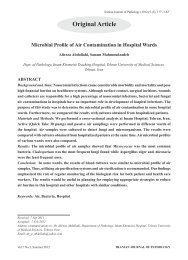World Health Organization Classification of Tumours Pathology and ...
World Health Organization Classification of Tumours Pathology and ...
World Health Organization Classification of Tumours Pathology and ...
Create successful ePaper yourself
Turn your PDF publications into a flip-book with our unique Google optimized e-Paper software.
cystic change may be seen. Solid, cordlikepatterns <strong>and</strong> sarcomatoid featuresmay be encountered. The sarcomatoidchange is a pattern <strong>of</strong> dedifferentiationsimilar to that seen in other types <strong>of</strong> renalcarcinoma {153}. The cells <strong>of</strong> collectingduct carcinoma usually display highgrade (Fuhrman 3 <strong>and</strong> 4) nuclear features.The cells may have a hobnail pattern<strong>of</strong> growth <strong>and</strong> the cytoplasm is generallyeosinophilic. Glycogen is usuallyinconspicuous in collecting duct carcinoma.Both intraluminal <strong>and</strong> intracytoplasmicmucin may be seen.Some tumours with other morphologieshave been proposed as collecting ductcarcinomas. The most frequent oneshave a predominantly papillary growthpattern but they differ from usual papillarycarcinoma by a lack <strong>of</strong> circumscription,broad stalks containing inflamedfibrous stroma, desmoplasia, highnuclear grade <strong>and</strong> sometimes an associationwith more typical tubular patterns <strong>of</strong>collecting duct carcinoma elsewhere{2470}. The central location <strong>and</strong> associatedtubular epithelial dysplasia (atypia)are helpful in supporting a diagnosis,although dysplasia may be seen in collectingducts adjacent to other types <strong>of</strong>renal carcinoma.Immunopr<strong>of</strong>ileTumour cells usually display positivity forlow molecular weight <strong>and</strong> broad spectrumkeratins. High molecular weight keratins(34βE12, CK19) are commonlypresent <strong>and</strong> co-expression <strong>of</strong> vimentinmay be seen {2470}. There is variableimmunostaining for CD15 <strong>and</strong> epithelialmembrane antigen. The CD10 <strong>and</strong> villinstains are negative. Lectin histochemistry,usual Ulex europaeus agglutinin-1<strong>and</strong> peanut lectin are commonly positive.Table 1.05Diagnostic criteria for collecting duct carcinoma.Major Criteria- Location in a medullary pyramid (smalltumours)- Typical histology with irregular tubulararchitecture <strong>and</strong> high nuclear grade- Inflammatory desmoplastic stroma withnumerous granulocytes- Reactive with antibodies to high molecularweight cytokeratin- Reactive with Ulex europaeus agglutininlectin- Absence <strong>of</strong> urothelial carcinomaMinor Criteria- Central location (large tumours)- Papillary architecture with wide, fibrousstalks <strong>and</strong> desmoplastic stroma- Extensive renal, extrarenal, <strong>and</strong> lymphatic<strong>and</strong> venous infiltration- Intra tubular epithelial atypia adjacent tothe tumourDifferential diagnosisThe main differential diagnoses <strong>of</strong> collectingduct carcinoma include papillaryrenal cell carcinoma, adenocarcinoma orurothelial carcinoma with gl<strong>and</strong>ular differentiationarising in renal pelvis <strong>and</strong>metastatic adenocarcinoma {2470}.ASomatic geneticsMolecular events that contribute to thedevelopment <strong>of</strong> collecting duct carcinomas(CDCs) are poorly understoodbecause only few cases have been analyzed.LOH was identified on multiplechromosomal arms in CDC, including 1q,6p, 8p, 13q, <strong>and</strong> 21q {2094}. Loss <strong>of</strong>chromosomal arm 3p can be found inCDC {674,990}. High density mapping <strong>of</strong>the entire long arm <strong>of</strong> chromosome 1showed that the region <strong>of</strong> minimal deletionis located at 1q32.1-32.2 {2501}.One study suggested that 8p LOH mightbe associated with high tumour stage<strong>and</strong> poor patient prognosis {2335}. Incontrast to clear cell RCC, HER2/neuamplifications have been described inCDCs {2357}.Prognosis <strong>and</strong> predictive factorsThe typical collecting duct carcinomashave a poor prognosis with many beingmetastatic at presentation. About twothirds<strong>of</strong> patients die <strong>of</strong> their diseasewithin two years <strong>of</strong> diagnosis {2470}.BFig. 1.41 Carcinoma <strong>of</strong> the collecting ducts <strong>of</strong> Bellini. A Tubulopapillary type <strong>of</strong> growth. B,C Note high gradecytological atypia.C34<strong>Tumours</strong> <strong>of</strong> the kidney



